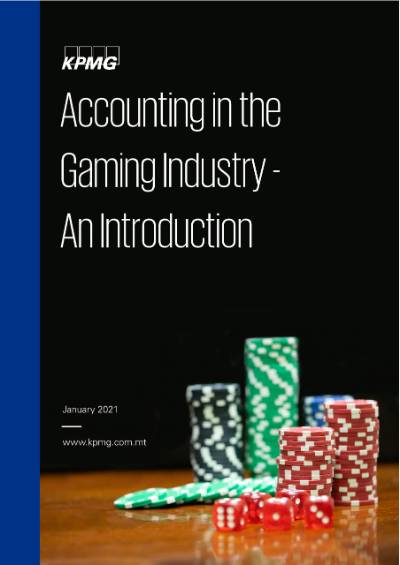As part of KPMG’s continuous effort to bring together industry stakeholders to discuss the latest issues in the gaming industry, we’re launching a new series of fact sheets to provide sector specific information. These will tackle various accounting topics which are of significant relevance to the industry.
These factsheets will delve into:
- Determining the functional currency;
- Capitalisation of internally generated intangible assets;
- Amortisation of intangible assets; and
- Revenue recognition.
IAS 21 The Effects of Changes in Foreign Exchange Rates
As part of the nature of their business, gaming entities operate across multiple jurisdictions and as a result of B2C (business to customer) transactions, they receive bets in various currencies. This may lead to uncertainties when determining the functional currency of an entity and poses a challenge for management in their assessment of the appropriateness of functional currencies.
IAS 21 provides guidance on determining the functional currency on a purely individual entity basis. The notion of group functional currency does not exist under IFRS. Entities applying IFRS need to carry out an assessment of the functional currency, because it is a key element especially when considering changes in the group structures which could affect entities’ autonomy from their parent or when implementing new strategies. It is also important to note, that notwithstanding the fact that the responsibility in determining the functional currency lies with the entity’s management, it is also the responsibility of the auditors to review critically and exercise professional judgement and scepticism, to ensure that the assessment made by management is appropriate and in accordance with IAS 21 principles.
IAS 38 Intangible Assets Capitalisation of internally generated intangible assets
For items to qualify as intangible assets, they need to lack physical substance and are identifiable, non-monetary and controlled by the entity and expected to provide future economic benefits to the entity. This might seem straightforward, however when gaming entities undergo significant projects such as, software developments to update their platforms, it may be challenging to assess whether internally generated intangible assets qualify for recognition. It may prove challenging to determine which costs would be eligible for capitalisation, due to problems in:
- Identifying whether and when there is an identifiable asset that will generate expected future economic benefits; and
- Determining the cost of the asset reliably. There could be cases, where the cost of generating an intangible asset internally cannot be distinguished from the cost of maintaining or enhancing the entity’s internally generated goodwill or of running day to day operations.
As a result, in addition to complying with the criteria to qualify as an intangible asset and the recognition criteria, to assess whether an internally generated intangible asset meets the recognition criteria, an entity is required to make a distinction between the research and development phase. Research costs would be recognised as expenses in profit or loss, whereas expenditure incurred during the development phase could be capitalised provided the relevant criteria are met.

Amortisation of intangible assets
The majority of companies operating within the gaming industry have some form of intangible asset on their balance sheet. Although intangible assets do not have a physical substance, they can be a significant element for a company to be able to operate successfully. Apart from goodwill, one of the most common intangible assets found on the books of gaming companies are gaming platforms. Like all other intangible assets, a platform must be amortised in line with the requirements of IAS 38 Intangible Assets if it has a finite useful life. If on the other hand, it is determined that the platform has an indefinite useful life, then it is not amortised, and it will be subject to impairment testing at least annually.
Although it might seem that the determination of the useful life of an intangible asset with a finite useful life is a very straight-forward exercise, this might not always be the case especially if the platform or intangible asset being recognised has a number of particular features. Hence, it is vital that internal and external factors are considered when it comes to determining the useful life of a platform or another intangible asset.
IFRS 15 Revenue from Contracts with Customers
One area of focus which elicits interest not only from a business perspective but also from an accounting point of view is revenue recognition. An interesting discussion is whether revenues are to be presented in line with gross amounts received, or in line with the net amounts pertaining to a business. To this end, the entity must determine whether it is a principal or an agent for any given transaction or series of transactions. Such a question is very relevant to Gaming companies, as the use of platforms or products developed by third parties is common.
A principal is defined by IFRS 15 as the entity that controls the specified good or service before that good or service is transferred to the customer and, as a result, the principal is required to present revenue and expenses in gross amounts. The agent, therefore, is the party in the transaction that does not have control over the good or service prior to the transfer occurring but has a performance obligation to arrange for the transfer of the good or service. As such, the agent is required to present revenue and expenses in net amounts even if gross cashflows go through the agent.
Determining which party holds control of the asset prior to the transfer to the end customer could either be relatively straightforward or a long and challenging discussion, especially since in the gaming industry to provide a service to the end customers could involve several other parties in the process.
Conclusion
The first topic fact sheet will be released by the end of January and will focus on determining the functional currency.
Jonathan Dingli
Partner, Corporate Accounting Advisory Services
KPMG in Malta
Connect with us
- Find office locations kpmg.findOfficeLocations
- kpmg.emailUs
- Social media @ KPMG kpmg.socialMedia


